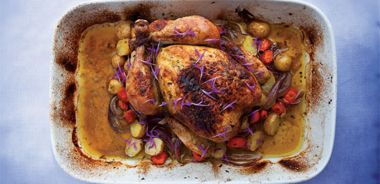Orange Bergamot Roast Chicken

This updated take on a classic roast chicken is perfect served at home to your family or as the star of your next dinner party.
1 orange, zested and juiced
2 Tbsp (30 mL) extra-virgin olive oil
2 tsp (10 mL) rice vinegar
3/4 tsp (4 mL) salt, divided
1/4 tsp (1 mL) freshly ground black pepper
3 Tbsp (45 mL) finely chopped unsprayed edible bergamot leaves
1 whole chicken (about 3 lb/1.5 kg), rinsed and patted dry
1 medium red onion, cut into 16 wedges
2 large carrots, cut into 1/2 in (1.25 cm) coins
10 new potatoes, cut in half
1/4 cup (60 mL) low-sodium chicken stock or vegetable stock
Bergamot petals, washed and dried (as garnish)
Preheat oven to 400 F (200 C).
In bowl whisk together orange zest and juice with oil, vinegar, 1/2 tsp (2 mL) salt, pepper, and bergamot leaves until emulsified.
Place chicken in roasting pan, breast up, and tuck wing tips under. Run fingers under chicken skin to loosen and pour half the orange mixture under skin, trying to cover as much as possible of the breast and thighs. Pour remaining orange mixture over chicken. Tie legs together with kitchen string at ankles. Place onion wedges, carrot, and potatoes around chicken, and sprinkle with remaining 1/4 tsp (1 mL) salt. Pour stock over vegetables. Roast chicken for 35 minutes.
Baste with cooking liquid and continue roasting, basting chicken every 10 minutes, until thermometer inserted in thickest part of thigh registers 185 F (85 C), about another 40 minutes.
Transfer chicken to platter and let rest 15 minutes before carving. Transfer vegetables to large bowl and keep warm. Pour pan juices into small pot and let sit for 10 minutes.
When ready to serve, carve or cut chicken into 8 pieces. Keep chicken bones to make homemade chicken stock.
Place vegetables on serving platter, top with chicken pieces, and garnish with bergamot petals, if desired. Skim fat from surface of pan juices, warm gently over medium heat, and serve alongside chicken.
Serves 8.
Each serving contains: 391 calories; 25 g protein; 14 g total fat (3 g sat. fat, 0 g trans fat); 43 g total carbohydrates (4 g sugar, 3 g fibre); 308 mg sodium
source: "Cooking with Edible Flowers", alive #359, September 2012





